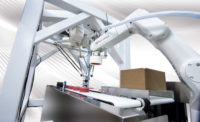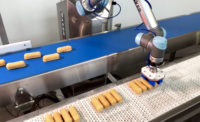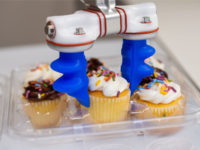Designing robotics for packaging functions in snack and bakery plants is a challenge. This market segment requires robots that are highly flexible for product changeover, yet easy to program. Robots must be sanitary in nature and offer a broad expanse of speed, payload and reach capabilities. Limited floor space is another challenge, so designing robotics solutions within a small footprint is vital.
“The bakery/snack environment is a challenge in that there is often flour, and in some cases oil, to deal with. This means the machines must be easy to clean, and be food-safe when handling primary goods. Tooling has to be hygienic, as well as gentle on the product,” says Craig Souser, president, JLS Automation, York, PA.
The good news is new robotics technology is available to help improve these operations in both primary and secondary packaging applications. Areas of innovations include end-of-arm tooling (EOAT), robot learning, sanitation and space optimization.
Get a grip
Matt Wicks, vice president, product development, Honeywell Intelligrated, Mason, OH, has seen some interesting developments in robotics grasping that utilize soft robotics, a technology that expands the types of items a robot can handle. “Many food items are comprised of materials that are difficult to handle, like doughs and other soft goods that have proven to be especially challenging for rigid robotics tooling. Soft robotics technology is opening up new applications.”
Highly flexible EOAT is now available for products that are delicate in nature, according to Dean Elkins, segment leader, Handling and Consumer Products Group, Yaskawa Motoman, Miamisburg, OH. “These end effectors can be manufactured from materials that are food-grade-safe, and they are highly reactive in terms of speed and compliance.”
Colborne Foodbotics, Lake Forest, IL, is constantly creating innovations in the EOAT portion of its packaging systems to handle the varying degrees of variability in food products. This requires that the company think outside the box to design and manufacture tools that are reliable and efficient in picking and placing, according to Rick Hoskins, president.
“For example, where we used to use pneumatic devices on EOAT, we’ve switched to linear motors, which offer more-efficient operation and flexibility. The developments within our EOAT improve the ability of our customers to handle more products, which allows them to implement robotics today when they couldn’t yesterday,” Hoskins notes.
Carl Vause, chief executive officer, Soft Robotics, Cambridge, MA, says one of the greatest needs in bakery operations today is for high-speed pick and place in both secondary and primary product handling. “Traditionally, this has been difficult due to the varying and delicate nature of bakery/snack products. The traditional approach to this automation has been custom tooling and specific robotics programming by SKU in a high-mix, high-volume environment. With Soft Robotics’ solutions, bakery/snack operators are able to run high-mix, high-volume applications without the need for multiple tooling solutions and robot programming.”
Work smarter
Advances in robot learning also are taking place. “Vision and artificial intelligence is allowing robots to learn through product consistencies and by trial and error. This type of learning is applicable in bakery/snack operations that move goods on conveyors and require accurate placement into packaging materials,” Elkins says.
FANUC America, Rochester Hills, MI, offers vibration learning control on a number of its robots, including the M-3iA and M-1iA delta robots for high-speed picking and packing. This software optimizes the robot’s motion by learning the unique path characteristics of the actual application. “It reduces the skill set required to optimize cycle time by allowing the robot to determine the best possible motion. It also reduces the integration and startup time, along with improving cycle time up to 10 percent,” says Wes Garrett, account manager.
To comply with the sanitation needs imposed by the snack and bakery industry, robots that come in direct contact with unpackaged products are available with food-grade grease rather than petroleum-based grease to mitigate potential contamination. “This feature can be found in Yaskawa’s line of MPP3 series delta robots, as well as the GP7, GP8 and GP12 articulated robot models,” Elkins says.
New robotics also features space-saving designs. For example, smaller-footprint controllers, such as the Yaskawa YRC1000 and YRC1000micro, easily fit into tight areas. “Collaborative robots, such as the Yaskawa HC10 and HC10DT, help minimize the amount of floor space required for safety equipment based on an adequate risk assessment. This allows robots to assist humans in a shared workspace,” Elkins adds.
These robotics innovations improve packaging operations in the following key areas, according to Eric Aasen, product sales manager, Bosch Packaging Technology, New Richmond, WI:
- Gentler handling. Snack and bakery manufacturers need technology that is capable of handling foods that may break easily; this is one of the reasons EOAT technology is key for these applications.
- Increased production speed. Adding robots to production lines can accelerate the packaging process. The range of success depends on individual product characteristics.
- Smoother production process. The use of robots not only eliminates the risk of human error and the need for staff training, it also minimizes downtime and product waste. In addition, many robots come equipped with software that can help with monitoring and troubleshooting.
“For example,” says Aasen, “the latest software allows operators to prepare recipes and production processes offline and simulate runs, helping to reduce set-up time for new batches.”
The challenge of using robotics technology is mainly defined by the product characteristics of each application. “To handle a wide variety of products, Bosch offers more than 2,000 types of EOAT, ensuring high-speed picking, placing and packing, as well as gentle handling of delicate products. Bosch delta robots are widely used to handle dry foods, such as biscuits, baked goods, chocolate and cereal bars,” Aasen adds.
The latest robots are self-monitoring, can analyze errors and provide troubleshooting tips. “Many of the advanced robotics systems have some level of self-monitoring that can provide details such as troubleshooting tips. It is commonplace for a robotics system to have some level of smart sensors and error reporting to aid in troubleshooting,” Wicks says.
One example is FANUC America’s robot lineup featuring an R-30iB Plus controller platform. It includes Zero Down Time (ZDT) software, which collects, stores and analyzes the robot data every 90 seconds. It then runs analytics on the data collected to minimize or eliminate downtime, maximize throughput and extend the life of the robot.
Secondary specifics
Among recent introductions to the market, FANUC America recently unveiled the SCARA SR series of robots, which are suitable for secondary picking and packing applications. “We offer two SCARA variants–one with a 3-kg payload and 400-mm reach and another with a 6-kg payload and 650-mm reach. These robots feature a compact controller along with iRProgrammer software that allows for quick and easy setup from a tablet or PC without the need for a teach pendant,” Garrett says.
JLS Automation recently introduced its Next Generation robotics platform, which features an integrated motion (robot controller) with programmable logic controller (PLC) and human-machine interface (HMI). “It reduces the number of interfaces, the software required and the electrical footprint. The system also gives us the ability to run any number of generic robots—whatever is appropriate for the task at hand,” Souser says.
BluePrint Automation, South Chesterfield, VA, has introduced a two-robot case-loading system with vision that allows users to pack vertical and horizontal on the same line. Built for quick changeover between recipes, the Spider 300v is capable of handling standard regular slotted carton (RSC) cases, three-sided displays and a wide range of other containers. “The system features a modular frame designed to reduce cost by minimizing wiring and the machine footprint,” says Joel Wiskochil, regional sales manager.
Future developments
What robotics innovations do experts foresee in the near future for the snack and bakery segment?
Souser says JLS Automation is starting to use 3D cameras to count the pieces of a product in a stack and perform higher-level inspections. “We also are investigating food-grade 6-axis robots for primary product-handling applications. Down the road, use of data mining will help bakery/snack producers increase overall equipment effectiveness (OEE) and reduce operational costs as the information can be acted on in advance of an issue—all under the heading of Industry 4.0.”
Some experts believe that cobots, robots designed to collaboratively work with humans in a shared workspace, will have a place for certain operations in baking, helping to bring even more automation to the industry.
“Cobots do not require the safety caging that traditional robots do,” says Stan Prutz, CEO and president, QDS Systems, Baton Rouge, LA. “Work areas can be designed for people and cobots to work side-by-side on tasks. Also, cobots can offer a temporary helping hand, especially if set up on a mobile cart.”






